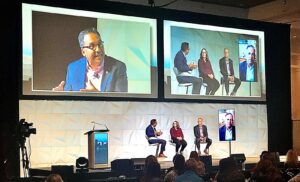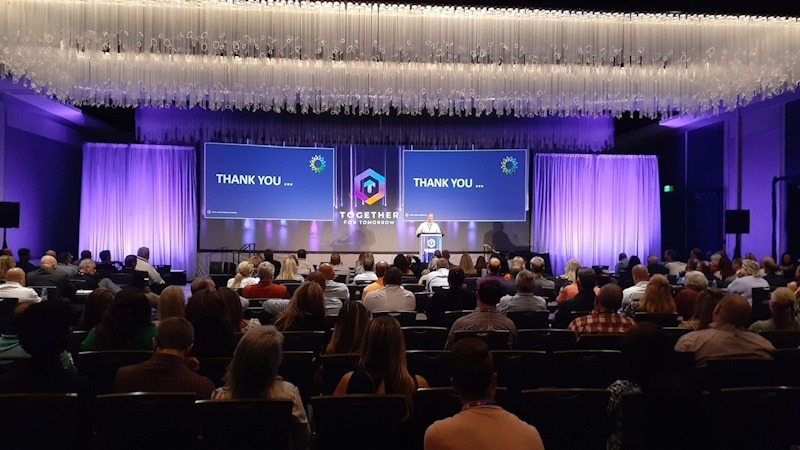The pandemic has fundamentally changed the way we plan for our meetings and events, and site visits with audio visual partners are no exception. The essential function of a site visit remains the same: we spend an entire day looking at the venue, what space has been blocked, and what room requirements we have to work with. We’ll assign different sessions to different rooms and make sure that the creative elements we’ve selected will work within the space provided. We dive into the specifics with the venue making sure we have enough equipment down to the extension cords.
So what’s different now? The biggest thing we advise our clients is…
Don’t sign a venue contract before you consult your AV partner
A little self-serving, we know. But this is really important for meeting costs and functionality. In the early days of the pandemic, venues showed a lot of empathy and flexibility in helping planners navigate the everchanging rules. But we’ve seen that willingness dissipate as the pandemic continues, resulting in stricter contracts with less wiggle room. Additionally, in the case of big hotel chains, we’ve seen costs skyrocket. This is especially true of the technology services from onsite vendors – things like labor, rigging, power, and internet have really increased.
This, of course, means your AV partner needs to be selected before the venue, which is sometimes out of order for standard planning processes. But there can be big time and money savings to do so. And in line with current industry trends like hybrid events and on demand recording, having your AV partner selected early is a strategic benefit.
Understand your space
One of the most underrated ways to save costs is to have your AV provider map out how much space and equipment you really need. With your event vision in mind, they can tour the venue and help you decide what type of space is going to make your event a success. Especially if you’re planning a hybrid event, there may be creative ways to cut down on breakout room space. Or perhaps the team can design a cost-friendly stage that uses some of the existing room elements. On another note, they can also help identify limitations to the space based on what you’re looking to do and help suggest alternatives. It’s all about optimizing the AV for the room.
Negotiate out frivolous costs
Partnering with your chosen AV company, review the contract sent to identify areas to negotiate out costs. For example, we worked with one client this year who had a $3,500 elevator fee in their contract. A fee… to use the elevator! Experienced AV companies have seen a lot of venue contracts and should understand where the venues have room to lower or eliminate costs.
We’re also starting to see exclusivity clauses inserted into contracts. They may say that you can use an AV supplier of your choice for General Sessions, but any breakout room must be serviced by the in-house company so they can reap the labor costs. Keep an eye out for things like this that limit your ability to be flexible.
We are finding that convention centers have been generally more responsive than hotels. Because their vendors are separate and preferred (instead of required), you’re negotiating smaller contracts with different vendors instead of one big contract. We believe this means you have better negotiating power as you can tackle them one by one.
Some hotels will hold hard and fast to their charges and there isn’t much you or the AV partner can do, but it’s better to have this negotiation upfront than try and get certain fees waived or reduced throughout the event itself.
Think through the tech
Most of the Covid protocols are behind us (think social distancing, staggering the flow between breakouts, etc.), but there are some permanent changes we need to account for. Most notably, we’re still seeing – and encouraging – more room spacing for attendees especially in the large general sessions. Now the standard is two people per a six-foot table or eight at a round, which not only helps with safety but is much more comfortable for attendees. It does mean you need more tables, and therefore more space, so the tech needs to accommodate that.
For a recent event that had over 1,000 in-person attendees, we utilized delay screens and staged extra speakers. The experience should be the same for everyone regardless of their seat.
Another hot topic is power and internet. If you’re planning any type of hybrid component, even just streaming to YouTube or Facebook, you must have multiple internet sources in multiple rooms. And even if you’re not planning on streaming, you need to think through the internet requirements of the attendees and presenters. Days of passing around a shared microphone for Q&A are behind us, so if you’re utilizing a conference App for the engagement piece, every attendee needs to be able to access the internet to participate.
 Meetings today have also bent the traditional rules we followed. Planners now have more options when it comes to finding presenters because not everyone needs to be onsite. We’ve helped engineer panels that had a remote participant by adding a monitor to the stage to give the feeling they were there. The world of possibilities in all areas of the event have opened, and your AV partner can help you take advantage of that.
Meetings today have also bent the traditional rules we followed. Planners now have more options when it comes to finding presenters because not everyone needs to be onsite. We’ve helped engineer panels that had a remote participant by adding a monitor to the stage to give the feeling they were there. The world of possibilities in all areas of the event have opened, and your AV partner can help you take advantage of that.
Site visits help clarify just about everything
A site visit is a chance to meet all the vendors you’ll work with onsite if you haven’t already. You should capitalize on this time together by getting to know how each vendor operates. It’s important to understand how they work, how it’s best to communicate during the event, who to reach out to for emergencies, etc. Building this knowledge now saves your precious time right before the show.

And it’s also a chance to have fun! So much work goes into planning these events and you deserve to enjoy the people you’re working with. One of our clients had done virtual meetings with us in 2020 and 2021, and when we did their site visit for their upcoming 2022 live event, it was actually the first time we met in person! After a full day at the venue walking through the specifics, we spent time seeing sights around town and enjoying the company. It further solidified the relationship and strengthened the planning team heading into the final critical months of planning.
Going without an AV partner?
Sometimes your selected partner can’t go, or maybe you’re using the in-house provider. Make sure you prep for the visit in this area so you know to ask the right questions and thoroughly understand the contract terms. Target to go around six months before your show. We’ve found this to be a good timeframe – early enough to plan and prepare, but within enough time that you don’t forget what you saw.
We love site visits because it’s an opportunity to put our creativity to work and spend time with our clients. Like most things from the pandemic, we’ve adapted our best practices to fit the new needs of events today. It’s a chance to take the big picture and narrow it down to the details all while aiming to reduce unnecessary costs.
We encourage you to think through your current site visit process and see where it can be enhanced to better plan and prepare for your future meetings.
At Image Audiovisuals, we’re always happy to be a consultative partner and share our best practices for a wide range of av services. Give us a call today!
Talk To Us












